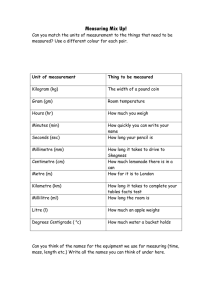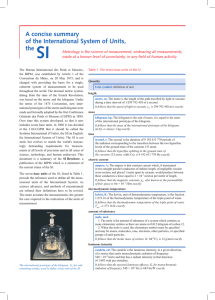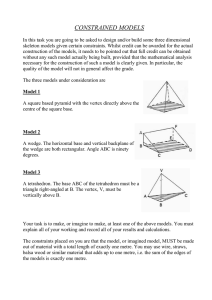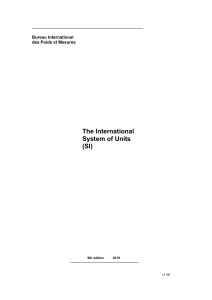Resumen del Sistema Internacional de Unidades
advertisement
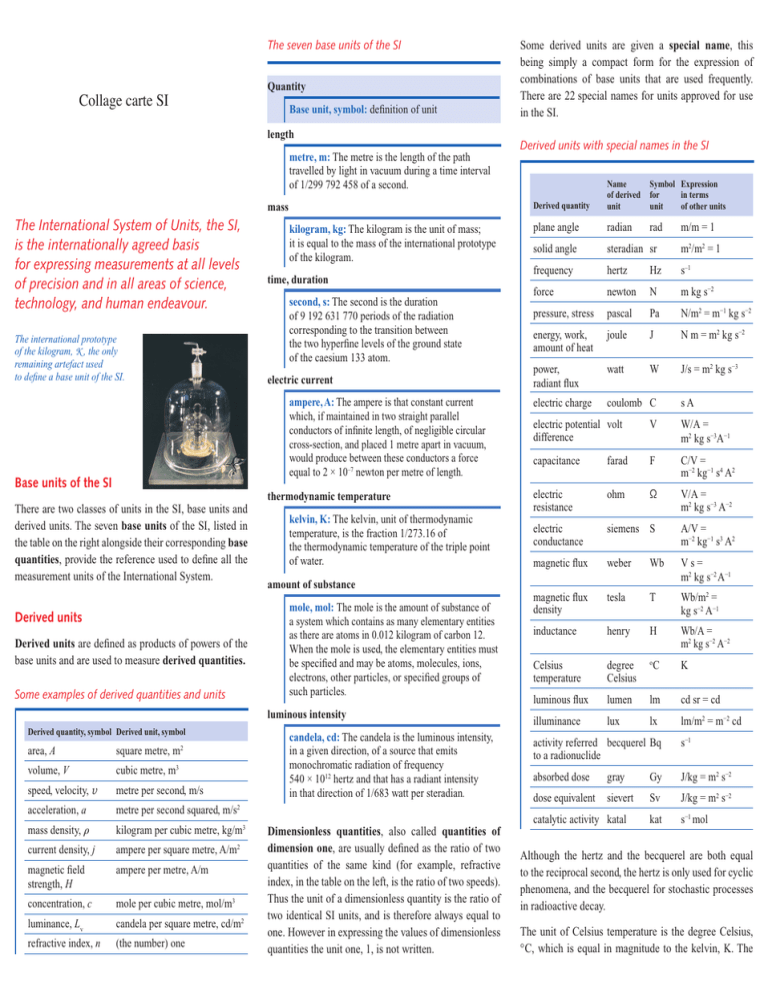
The seven base units of the SI Collage carte SI Quantity Base unit, symbol: definition of unit length metre, m: The metre is the length of the path travelled by light in vacuum during a time interval of 1/299 792 458 of a second. mass The International System of Units, the SI, is the internationally agreed basis for expressing measurements at all levels of precision and in all areas of science, technology, and human endeavour. The international prototype of the kilogram, K , the only remaining artefact used to define a base unit of the SI. kilogram, kg: The kilogram is the unit of mass; it is equal to the mass of the international prototype of the kilogram. time, duration second, s: The second is the duration of 9 192 631 770 periods of the radiation corresponding to the transition between the two hyperfine levels of the ground state of the caesium 133 atom. electric current ampere, A: The ampere is that constant current which, if maintained in two straight parallel conductors of infinite length, of negligible circular cross-section, and placed 1 metre apart in vacuum, would produce between these conductors a force equal to 2 × 10–7 newton per metre of length. Base units of the SI There are two classes of units in the SI, base units and derived units. The seven base units of the SI, listed in the table on the right alongside their corresponding base quantities, provide the reference used to define all the measurement units of the International System. Derived units Derived units are defined as products of powers of the base units and are used to measure derived quantities. Some examples of derived quantities and units thermodynamic temperature kelvin, K: The kelvin, unit of thermodynamic temperature, is the fraction 1/273.16 of the thermodynamic temperature of the triple point of water. amount of substance mole, mol: The mole is the amount of substance of a system which contains as many elementary entities as there are atoms in 0.012 kilogram of carbon 12. When the mole is used, the elementary entities must be specified and may be atoms, molecules, ions, electrons, other particles, or specified groups of such particles. luminous intensity Derived quantity, symbol Derived unit, symbol area, A square metre, m2 volume, V cubic metre, m3 speed, velocity, v metre per second, m/s acceleration, a metre per second squared, m/s2 mass density, kilogram per cubic metre, kg/m3 current density, j ampere per square metre, A/m2 magnetic field strength, H ampere per metre, A/m concentration, c mole per cubic metre, mol/m3 luminance, Lv candela per square metre, cd/m2 refractive index, n (the number) one candela, cd: The candela is the luminous intensity, in a given direction, of a source that emits monochromatic radiation of frequency 540 × 1012 hertz and that has a radiant intensity in that direction of 1/683 watt per steradian. Dimensionless quantities, also called quantities of dimension one, are usually defined as the ratio of two quantities of the same kind (for example, refractive index, in the table on the left, is the ratio of two speeds). Thus the unit of a dimensionless quantity is the ratio of two identical SI units, and is therefore always equal to one. However in expressing the values of dimensionless quantities the unit one, 1, is not written. Some derived units are given a special name, this being simply a compact form for the expression of combinations of base units that are used frequently. There are 22 special names for units approved for use in the SI. Derived units with special names in the SI Derived quantity Name of derived unit Symbol Expression for in terms unit of other units plane angle radian rad solid angle steradian sr m2/m2 = 1 frequency hertz Hz s–1 force newton N m kg s−2 pressure, stress pascal Pa N/m2 = m−1 kg s−2 energy, work, amount of heat joule J N m = m2 kg s−2 power, radiant flux watt W J/s = m2 kg s−3 electric charge coulomb C m/m = 1 sA electric potential volt difference V W/A = m2 kg s−3A−1 capacitance farad F C/V = m−2 kg−1 s4 A2 electric resistance ohm Ω V/A = m2 kg s−3 A−2 electric conductance siemens S A/V = m−2 kg−1 s3 A2 magnetic flux weber Wb Vs= m2 kg s−2 A−1 magnetic flux density tesla T Wb/m2 = kg s−2 A−1 inductance henry H Wb/A = m2 kg s−2 A−2 Celsius temperature degree Celsius o luminous flux lumen lm cd sr = cd illuminance lux lx lm/m2 = m−2 cd C K activity referred becquerel Bq to a radionuclide s−1 absorbed dose gray Gy J/kg = m2 s−2 dose equivalent sievert Sv J/kg = m2 s−2 kat s−1 mol catalytic activity katal Although the hertz and the becquerel are both equal to the reciprocal second, the hertz is only used for cyclic phenomena, and the becquerel for stochastic processes in radioactive decay. The unit of Celsius temperature is the degree Celsius, ° C, which is equal in magnitude to the kelvin, K. The quantity Celsius temperature, t, is related to thermodynamic temperature, T, by the equation: t/° C = T/K – 273.15. Decimal multiples and sub-multiples of SI units A set of multiple and sub-multiple prefixes have been adopted for use with the SI units. They may be used with any of the base units and with any of the derived units with special names. The SI prefixes Factor Name Symbol Factor Name Symbol 101 deca da 10−1 deci d 102 hecto h 10−2 centi c 10 3 kilo k 10 −3 milli m 10 6 mega M 10 −6 micro µ 109 giga G 10−9 nano n 10 12 tera T 10 pico p 1015 peta P 10−15 femto f 10 −12 exa E 10 atto a 1021 zetta Z 10−21 zepto z 10 yotta Y 10 yocto y 18 24 −18 −24 When the prefixes are used, the prefix name and the unit name are combined to form a single word, and similarly the prefix symbol and the unit symbol are written without any space to form a single symbol, which may itself be raised to any power. For example, we may write: kilometre, km; microvolt, µV; 50 V/cm = 50 V (10–2 m)–1 = 5000 V/m. The kilogram, kg, is an exception, because although it is a base unit the name already includes the prefix kilo, for historical reasons. Multiples and sub-multiples of the kilogram are written by combining prefixes with the gram: thus we write milligram, mg, not microkilogram, µkg. Units outside the SI The SI is the only system of units that is universally recognized, so that it has a distinct advantage in establishing a dialogue over the whole world. Nonetheless, for historical reasons some non-SI units are still widely used to meet the needs of special interest groups, or because there is no convenient SI alternative. It will always remain the prerogative of a scientist to use the units that he or she considers to be best suited to the purpose. However when non-SI units are used, the conversion factor to the SI should be quoted (with a few exceptions of very familiar non-SI units). Some of the most important and familiar non-SI units approved for use with the SI are the minute, symbol min, the hour, symbol h, and the day, symbol d, as units of time. Using the SI to express the values of quantities The value of a quantity is written as the product of a number and a unit. One space is always left between the number and the unit. The numerical value depends on the choice of unit, so that the same value of a quantity may have different numerical values when expressed in different units. For example, the value of the speed of a bicycle might be v = 5.0 m/s = 18 km/h. Quantity symbols are printed in an italic (slanting) type. Either capital or lower case letters may be used. Unit symbols are printed in a roman (upright) type, regardless of the type used in the surrounding text. They are mathematical entities and not abbreviations; they are never followed by a stop (except at the end of a sentence) nor by an s for the plural. They are written in lower case letters, except that the first letter is a capital when the unit is named for an individual (for example, ampere, A; kelvin, K; hertz, Hz; coulomb, C; but metre, m; second, s). The use of the correct form for unit symbols is mandatory. For each quantity, there is only one SI unit. However the same SI unit may be used to express the values of several different quantities. For example, the J/K is the SI unit of both heat capacity and entropy. It is therefore important not to use the unit alone to specify the quantity. The decimal marker may be either a point (i.e. a stop) or a comma, as is customary in the language of the surrounding text. When a number has many digits, it is customary to group the digits into threes about the decimal point for easy reading, using a (thin) space; neither a point nor a comma should be used. Because units symbols are mathematical entities, they may be treated by the ordinary rules of algebra. For example, the equation T = 293 K may equally be written T/K = 293. This procedure is described as the use of quantity calculus, or the algebra of quantities. It is often useful to use the ratio of a quantity to its unit for heading the columns of a table, or labelling the axes of a graph, so that the entries in the table or the labels of the tick marks on the axes are all simply numbers. For further information see the website of the Bureau International des Poids et Mesures, BIPM, at www.bipm.org This text is a short summary of the 8th edition of the SI Brochure, prepared by the Comité Consultatif des Unités (CCU) of the Comité International des Poids et Mesures (CIPM), and is published by the BIPM. Ernst Göbel, President of the CIPM Ian Mills, President of the CCU Andrew Wallard, Director of the BIPM March 2006 Bureau International des Poids et Mesures (BIPM) Organisation Intergouvernementale de la Convention du Mètre Collage carte BIPM Pavillon de Breteuil F-92312 Sèvres France The International System of Units SI Bureau International des Poids et Mesures www.bipm.org

